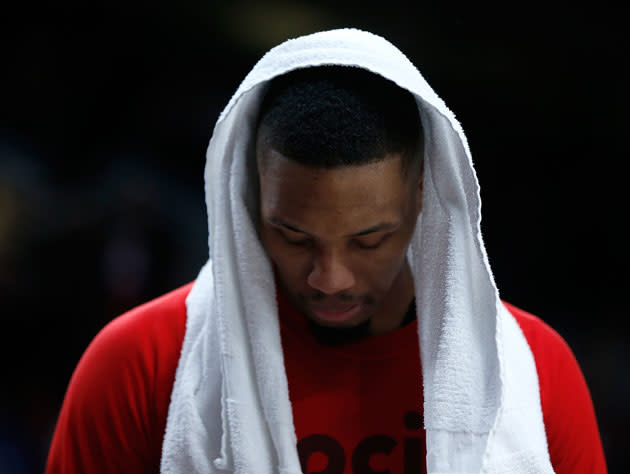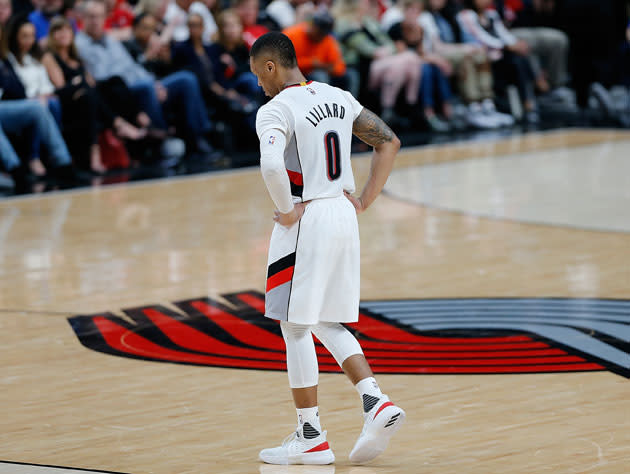Portland GM Neil Olshey laughs off odd criticisms of the Trail Blazers' 'failed culture'

When you’re in the mix – or out of it, apparently – the surface reflection of a mediocre, 41-41 NBA season doesn’t tell the whole story. The Portland Trail Blazers, after 82 games and a first-round playoff loss at the hands of the Golden State Warriors, don’t exactly look to be running in place. Not to those working through the day to day, from the six-game losing streams to the six-game winning streaks. To the sort of people who, when pressed, will guess that the Jusuf Nurkic trade happened about 742 days ago, instead of just ten weeks ago.
[Follow Ball Don’t Lie on social media: Twitter | Instagram | Facebook | Tumblr]
That’s what it feels like during an NBA campaign, even a mildly disappointing one. To call 2016-17 a lost season for the Portland Trail Blazers, with so much happening, feels a little pat. To insist that such a lost season is representative of a “flawed culture,” as Oregonian columnist John Canzano recently offered in a wrap-up column for his paper, seems a little more misguided.
In the same column, Canzano also talked up the gracious and pleasant and masterful and WHOLLY UNRELATED way Golden State Warriors reigning MVPs Stephen Curry and Kevin Durant deal with both team personnel, fans, and (unsurprisingly) the media. Portland general manager Neil Olshey went right in on Canzano in his State of the Blazers speech on Tuesday:
Olshey: Clearly the motivation was to abuse privileges as a media person so he could get tickets for his relatives and pics with Steph Curry pic.twitter.com/2NeUYbybaE
— CSN Northwest (@CSNNW) April 25, 2017
The “your tweet” in question came from Comcast Northwest Blazers beat reporter Jason Quick, who offered this anecdote in reaction to Canzano’s column:
FWIW: A column on culture from someone who spent – no exaggeration — zero seconds in Blazers locker room or practices this season. https://t.co/BQJR8mFbGV
— Jason Quick (@jwquick) April 25, 2017
Olshey’s thoughts on Blazers “culture,” thoughts that are now entering their fifth decade, went on, but not after the Oregonian’s YouTube feed decided to edit the GM’s quip about their star columnist:
Neil’s decision to never encourage the 2016-17 Trail Blazers to tank, as outlined in the clip above, is admirable. The team entered the All-Star break at 23-33 and left the season 26 games later with a .500 record, a remarkable accomplishment.
Olshey, for all of the faults that John Canzano weirdly ignored in his column, engineered as big a role in the 23-33 record as he did in the 18-8 finish to the season, especially when one considers the impact of the Jusuf Nurkic deal: Portland went 14-5 with the big fella in the starting lineup, following Olshey’s move to acquire the center a few days before a trade deadline that Olshey later characterized as “dead.”
Of course, that deal could have done work for whatever was perched on Olshey’s shoulder at the time. Had the Blazers continued to falter down the stretch, the team would have fallen a lower-rung lottery pick to go along with the two other first-rounders it acquired from Memphis and Cleveland. Had the Blazers gone 5-14 with Nurkic in the lineup, the whole play could be passed off as more draft-pick hoarding, combined with a flyer taken on a project that won’t turn 23 until August.
“I would have liked to have think we’d have turned it around,” Olshey said on Tuesday, discussing the team’s late-season coalescing alongside its new center, “but I don’t know. We had 56 games to turn it around, and we hadn’t.”
That the Blazers didn’t fold is to the franchise’s credit, but the fact remains that the team is still gone until November. Portland dipped three wins and a whole round’s worth of playoffs in its move from 2016 to 2017, while questions about the team’s backcourt makeup abound. Suddenly the pairing of star guards Damian Lillard and C.J. McCollum looks, to some if not many, to be as big a detriment as we once assumed a benefit for the club.
So much so that Olshey had to douse things during his season-ender, via CSNNW.com’s Quick:
“The odds of anything ever coming up of commensurate value is so hard to even fathom,’’ Olshey said when asked whether Lillard or McCollum were off limits in a trade. “I could give you the trite answer that ‘Nobody is untradeable,’ but clearly they are.’’
That appropriate response, that backed-into explanation, is why Portland is stuck in its stasis.
The question regarding Lillard and McCollum – undersized and slow defensively, and a layup waiting to happen for guards opposing PDX’s 24th-ranked defense – is hardly a question at all. Can the pair lead PDX to championship contender status amid their defensive faults? It’s unanswerable until the obvious hits. The two struggle on that end, and Portland was the worst defensive team in the 2017 playoffs, but that doesn’t mean the pair’s mitigating influences can’t be overcome.
It isn’t as simple as comparing the two’s station to that of Golden State’s backcourt, the lightning line on a Warrior team that Lillard thankfully admits to being “obsessed” with beating. Klay Thompson is lengthier, sturdier, and stronger than McCollum defensively, Stephen Curry has learned to overcome his defensive shortcomings in ways Lillard may never approximate. That doesn’t mean the Portland duo are ill-suited to work together in total, though, because in this league anything can work with the proper triptych in place for support.
That ideal runs deep. Perhaps not to the point where Isiah Thomas can be forgiven for pairing Eddy Curry alongside Zach Randolph, but we’re not far off.
The Blazers, however, are way off at the moment. Neil Olshey has tried to find that mix in his five years with the club, to middling success. He doesn’t look to have a fair amount of options moving forward, though, which is why the once-laughable idea of splitting up Dame and C.J. was discussed in hangman’s tones throughout the NBA this week.
The Blazers would drop McCollum and any number of those first-round picks in an instant were 2004-era Kevin Garnett suddenly to become available; if central casting comes calling, Neil is going to move. The options aren’t as plentiful for Portland moving forward in 2017, though, due to that same stasis – teams know the Blazers are looking to move parts that aren’t working, and Olshey will have to wait out the bad leverage deal in hopes that the typical batch of frantic clubs (they’re always out there, every summer) give enough to make a mix-up palatable, and NBA-legal at the same time.
Infamously, the club sported the league’s second-highest payroll in 2016-17, a byproduct of adding free agents Evan Turner (four years, $75 million) and Festus Ezeli (two years, $15 million) to the roster over the offseason at the cost of nearly $24 million for the two in 2016-17 alone. The club matched Brooklyn’s move to offer Allen Crabbe four years and $75 million, Meyers Leonard and Moe Harkless were no bargain to keep around, the pair received four-year extensions totaling $83 million. C.J. McCollum’s extension won’t take hold until 2017-18, but that $106 million counts.

Olshey doled out $354 million in contracts during the 2016 offseason. In return he took in the knowledge that McCollum is locked up until 2021, but also 41 wins, the knowledge that Ezeli’s coming buyout will limit that mark to just $347 million, and a sportswriter column complaining about a sportswriter’s inability to sit in the same seat Neil Olshey does before a game. (Seriously.)
That’s horrendous bang for the buck that reflects poorly on all involved, but not to the extent where you feel as if anyone should be on the firing line.
Because a high-usage trickster like Evan Turner still feels like the best guy to lead a bench unit in the second quarter, and the most frustrating thing is that he’ll probably excel in that role on his next team.
Because it makes sense to cycle through a series intriguing bigs with varying degrees of athleticism, working until you find the one that hits.
Because, with a coach like Terry Stotts, burrowing your way through rotation after rotation could pay off in spades. Once a coach like Terry Stotts is able to sink his teeth into a lineup worth taking advantage of, most past sins are forgiven.
Because there are only a handful of NBA players that you can trust to act as the biggest star in the room in a seven-game series against the feared opponent of your choice. Though the Trail Blazers just fell in four in the face of the expected champs from “Golden,” as Neil Olshey weirdly calls Golden State, Portland still feels as if it has one of those players in Damian Lillard.
Portland should feel that way, though the team’s fans shouldn’t be afraid to feel as if this run has gotten away from them.
Jusuf Nurkic’s arrival changed everything, and his presence will have to continue to act the warming point for Portland to return to this summer, when it finds its trade and free options potentially diminished by an uninterested market. If the food runner comes to the table with a 7-footer with skills, it doesn’t matter what you ordered – you take what’s on that tray. He was a standout (15 points and 10 rebounds in only 29 minutes, 3.2 assists and 3.2 combined steals/blocks) in his short time with the Blazers.
If that seems like a highly detailed role for a player that had all of Colorado angry at him (no easy feet) just 742 days ago just ten weeks ago, understand that a 14-5 record (prior to Nurkic’s foot injury) is no joke, and that it will be hard to find laughs in that room with that (still top-five) payroll sitting in the front row with his arms crossed. GMs will have to be worked over.
This is not an easy roster. Jusuf Nurkic’s fibular fracture will be a worry until he strings a few healthy months together. Crabbe failed to even approach the figurative corner, much less turn it, and it appears that we can relegate (even the not yet 22-years of age) Noah Vonleh to fringe status after 41 starts in 2016-17. In spite of Olshey’s continued praise:
Neil Olshey says Noah Vonleh's development excited him the most of any player this season.
— Mike Richman (@mikegrich) April 25, 2017
A position above, fans chanted for center Meyers Leonard’s removal – not just from the game or starting lineup should there be a Game 5, but from the team itself – on Tuesday:
A "please trade Meyers" chant starts. #ripcity pic.twitter.com/yuNI3SpS7P
— Pinwheel Empire (@pinwheelempire) April 25, 2017
Leonard, injury-bitten during the best of times, appeared shaken throughout the season and Olshey relays that it is a “day to day process” to keep Leonard’s “spirits up.” The loss of Kim Hughes, understandably let go after relaying team interests on record, was only part of the reason the center played most of the season in led boots.
Portland’s situation is not unique, in trying to string one star into two while cobbling together a full and fearsome rotation, and Neil Olshey’s best (read: most expensive) efforts can’t be compared to the way Bob Whitsitt madly put together his era-appropriate Trail Blazers toward the fin de siècle. Olshey ain’t mad.
It ain’t working so far, though. And no obvious solutions – beyond the luck of a trading partner, smitten with a member of that failed Blazer rotation and/or a sub-lottery pick – are on the horizon.
It appears a charmed culture, as defined by the local media, is the last thing this team needs to worry about.
Other teams that will be gone till November

 Yahoo Sports
Yahoo Sports 

